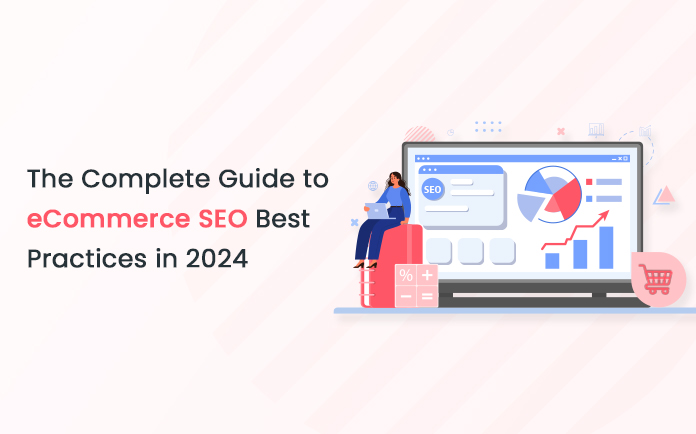Ecommerce SEO is all about making your online store more visible in search engine results like Google. As more people shop online and use search engines to find what they need, it’s important in 2024. It’s about change your website and products so they show up higher on the search results page, bringing more people to your site without having to pay for ads.
The benefits of solid ecommerce SEO are significant for any online business. Higher rankings lead to increased visibility and website traffic. This traffic converts to more sales and revenue as consumers find your products through searches. Additionally, good SEO improves brand credibility and awareness. Optimizing for keywords helps you reach consumers searching for those products and positions you as an authority. Implementing SEO best practices also improves the overall user experience by providing faster load times and easy site navigation.
This comprehensive guide covers the key areas of ecommerce SEO in 2024 that merchant websites must focus on. First, we examine crucial on-page elements including product titles, descriptions, categorization, images and site speed. Next, we dive into link building and earn backlinks from other sites. Finally, we explore how to create SEO-friendly content that engages visitors and encourages purchases. Following this advice will help ecommerce stores improve discoverability and drive conversions in 2024’s competitive landscape.
Keyword Research & Targeting
Conducting comprehensive keyword research provides the foundation for eCommerce developers to build an effective ecommerce SEO strategy. Identifying keywords that potential customers are using enables eCommerce developers to optimize site and product pages to rank for those searches. When eCommerce developers implement targeted keywords, it also helps drive relevant organic traffic that converts into sales.
The keyword insights should inform the decisions of eCommerce developers as they structure site architecture and content. With quality keyword research guiding SEO optimizations by eCommerce developers, online retailers can attract visitor traffic that strongly aligns with their product offerings and conversion goals. The efforts of eCommerce developers are most impactful when backed by strategic keyword targeting.
Identifying the Right Keywords
Choosing the right keyword targets to optimize for is one of the most important first steps of an ecommerce SEO strategy. Targeting specific keywords will allow you to drive more relevant organic traffic from search engines to your ecommerce site and product pages. It requires balancing metrics like search volume, competition levels, and consumer intent behind the keywords. Approaching keyword research methodically and utilizing the best tools will set your strategy up for success.
Driving Relevant Traffic with Targeted Keywords
Generic keywords with high traffic levels like “shoes” or “t-shirts” may seem enticing targets, but optimizing for such broad terms brings extremely high competition. Very few businesses can rank for these keywords. Instead, identifying more niche, targeted keywords in your market aligns better to your product inventory and offers achievable search volume. For example, an athletic shoe retailer would prioritize terms like “running shoes under $100” or “stability trail shoes for women”. Targeting such precise phrases brings traffic with higher sales intent, directly leading to more conversions.
Evaluating Short-Tail vs Long-Tail Keywords
Short-tail keywords and phrases only have one or two words while long-tail incorporates more context to extend the phrase. For instance, “tennis shoes” is a shorter phrase while “extra support tennis shoes for high arches” qualifies as a long-tail variant. The tradeoff is that shorter keywords have higher traffic potential but also face much higher competition. Longer-tail versions have lower search volumes given their specificity but also come with less competition. A balanced target list utilizes shorter, broader phrases for wider reach while also targeting niche long-tail versions aligning to your product inventory strengths.
Leverage Tools to Identify Volume, Competition & Intent
Keyword research tools provide the hard data needed to evaluate options on metrics like monthly searches, competition levels, and search intent. Google Keyword Planner offers free keyword volume estimates and suggested related keywords. Ahrefs is a powerful paid alternative providing additional competition, click-through rates and search analysis. Gather keyword suggestions then compile possibilities into a master list with associated volume, competition, relevancy and conversion potential scores. Sort and prioritize according to which align best as targets for your products. Also consider seasonality trends and location targeting for opportunities. These tools take the guesswork out by quantifying metrics to focus efforts.
Careful keyword research and analysis provides the foundation upon which an entire SEM and SEO strategy rests. Identify a mix of precise product and category terms that provide sufficient volume, conversions and healthy competition scores. Grouping these keywords and consistently tracking performance discovers new possibilities and helps maximize ROI long-term from organic and paid search channels. With the right homework, your ideal customer traffic lies just on the other site of targeting the perfect keywords for each unique situation and inventory set.
Keyword Integration Strategies
Once the keyword research is complete and high-priority terms have been identified, the next step is integrating those keywords into product pages and website content in strategic ways. Proper keyword integration matters just as much as selecting the right keyword targets. Optimizing pages with keywords will not benefit rankings if done ineffectively or the approach comes across as spammy or manipulative. This section covers best practices to organically incorporate keywords across an ecommerce site.
Natural Integration
Simply stuffing a page full of keyword repeats does nothing for rankings and actually hurts the user experience. Effective keyword integration requires identifying the most relevant pages and adding keywords in a thoughtful, seamless manner. The goal should be natural use that complements the existing content rather than overt keyword stuffing. This means repeating the terms only as often as necessary for the content without going overboard. Writing quality, reader-focused content that engages visitors should take priority over jamming in keywords wherever possible. Synonyms, related terms and rephrased variations help incorporate keywords without awkward or excessive repetition.
Place Keywords Strategically Within the Content
Where and how keywords appear on the page also impacts relevance and rankings. Start by working the keyword into meta title tags and descriptions, as search engines scan these elements to understand the page topic. Headings and image alt text also weigh heavily into keyword density signals. Within the body content, introducing keywords early helps set the topic focus. Sprinkle variations and related terms throughout naturally. Wrap up by circling back in the conclusion to the core conceptual keyword. Think about what words and phrases capture the most critical page concepts and ensure at least 5-7 instances total or a 2-3% keyword density. Too many distracts from the content flow; too few fails to establish relevance.
Expand Reach with Semantic Keyword Variations
To expand beyond single keyword optimization, identify semantic keyword themes related to those phrases. For example, around a core term like “athletic shoes”, semantic themes include synonyms like sneakers, footwear related phrases like physical fitness shoes or gym shoes, and descriptive variations like high performance shoes. Work these into the copy around the core keyword target organically. Linking internal product categories or related pages around the semantic circle also helps search engines make contextual connections. This technique builds authority around keyword themes to own the full search landscape.
The key guidelines for effective keyword integration include natural incorporation of terms into high-value places, using semantic keyword expansion to extend reach, finding the right repetition balance without overstuffing, and crafting engaging page copy beyond keywords for a quality user experience. Follow these strategies for seamless keyword optimization.
On-Page Optimization for eCommerce
On-page optimization refers to the practice of optimizing individual webpages through elements presented directly within the content of that page. For ecommerce, this means ensuring product and category pages implement SEO best practices on-site to drive organic performance.
Product Page Optimization
Product detail pages present one of the biggest opportunities to implement ecommerce SEO best practices. These pages feature the most information about each specific item in your catalog. Ensuring product titles, descriptions, images and other elements put their best foot forward improves organic visibility and conversion rates. Follow these key guidelines for product page optimization.
SEO-Friendly Title Tags
The HTML title tag tells both users and search engines the topic of a webpage. Keep product page titles concise, under 60 characters. Position the most critical keywords and product specifics like brand, item type and other descriptors up front. Avoid overuse of site branding in titles. Utilize key identifiers and keywords that differentiate products while describing what makes that item unique.
Tailored Product Description Copy
The product description field provides flexibility for lengthy copy detailing product features and benefits. Craft the first paragraph as a robust intro overview highlighting important characteristics and functions in an engaging style that appeals to customers. Incorporate related keywords and synonyms naturally. Follow with paragraphs expanding more on product capabilities, specifications, components and other relevant details with keywords interwoven. Include visual formatting like bullet lists for skimmable density. Use tools like Frase or MarketMuse to optimize language, sentiment and engagement.
Quality Images with Keyword Alt Text
Imagery helps customers visually evaluate products. Optimize images file sizes to enable fast page loading. Showcase products attractively in lifestyle scenarios when possible. Ensure colors appear accurate. Use keywords within file naming conventions for relevancy clues but avoid overstuffing that looks spammy. Write detailed alt text descriptions with precise keywords to improve context. Host images on fast, modern CDNs and compress files for performance wins.
Structured Data via JSON-LD Markup
Structured data markup enables search engines to pull enhanced product snippets called rich results. JSON-LD lets you embed code with specific schema types like Product structured data. For ecommerce SEO, this presents product images, pricing, ratings, availability data directly in the SERPs. It improves click-through-rates by offering more contextual preview info attracting consumer interest.
These elements all contribute to well-rounded product pages optimized for higher rankings, clicks and conversions plus better overall user experience. Review product pages to ensure each aspect meets best practices for maximum SEO and sales impact.
Blog Content & Long-Tail Keywords
Incorporating an active blog that generates fresh, valuable content on a recurring basis offers multiple SEO wins for ecommerce sites. Blog posts enable targeting long-tail keywords and topics that align to specialized product niches. For example, an outdoor retailer could create guides like “Beginner Hiking Gear: 20 Essential Items” or “Choosing the Best Camping Tent Based on Season”. Optimizing these posts for long-tail searches drives organic traffic for those specific queries.
These blog articles also provide opportunities for contextual internal linking by pointing readers to related gear and categories on-site. This connects your expertise around those phrases to enhancing your product offerings and inventory in the search engine’s understanding. The downstream impact results in improvements for both rankings around long-tail semantics as well as product discoverability and access. Enhanced relevancy lifts entire product categories. That’s the strategic power of leveraging blog content for ecommerce SEO success.
Technical SEO for eCommerce
Technical SEO factors like site speed, internal linking architecture, structured data markup and code optimization are critical for ecommerce ranking success but often overlooked by eCommerce developers. Optimizing these behind-the-scenes elements enables faster indexing, more effective crawling, contextual content understanding and increased click-through rates from search results.
Website Speed & Performance
Site speed and performance serve as critical elements of technical SEO needed for top ecommerce results. Research shows that even one second of slowing page load time reduces conversions over 10%. Faster sites also rank better with search engines like Google directly incorporating speed as an algorithmic ranking factor. Optimizing site performance should be a top priority.
Start by enabling GZIP compression and browsers caching of static assets like images, CSS and JavaScript files through cache control headers. Adopting a fast host helps as well. Audit site speed with online tools like Google PageSpeed Insights and GTmetrix then optimize anything scoring poorly. Eliminate render-blocking scripts, reduce server response times, minify CSS/JS files, resize bulk images, and lazy load non-critical assets. Implementing site performance best practices improves conversions alongside SEO. Achieving quick mobile load speeds prepares ecommerce stores for Google’s increasingly mobile-first index too. Delivering fast experiences drives organic growth.
Site Architecture & Navigation
A logical and intuitive website structure with easy navigation pathways facilitates positive user experiences that encourage conversions. At the same time, site architecture also impacts SEO through defined relationships that assist search engine crawling prioritization.
Ensure websites categorize similar products together in a clear taxonomy. Describe categories accurately utilizing targeted keywords within folder names and descriptions visible to crawlers. Implement sensible breadcrumb navigation trails to guide visitors clicking through multilevel categories towards products.
Define internal link structures that connect highly related pages using contextual anchor text and image links pointing deeper into category and product pages. This creates an optimal crawl hierarchy for search bots to follow, index new pages faster and reinforce relevancy associations. Ideally internal links utilize keywords and surrounding content pointing visitors to complementary products they may also have interest in.
Solid site architecture, taxonomy and internal linking provides a foundation upon which to build SEO visibility. Taking the time to thoughtfully optimize these elements enhances organic rankings by improving crawl efficiency and contextual connections for better indexing.
XML Sitemap & Search Console
Creating and submitting an XML sitemap facilitates search engine indexing by clearly outlining every page search bots should crawl on a website. This helps ensure all products and content get discovered.
An XML sitemap acts as an index or table of contents, consisting of a list of URLs and associated metadata like last updated dates and crawl frequency hints. List all site pages, especially product and category URLs within the sitemap. There are plugins to auto generate sitemaps.
Upload and submit the finished XML sitemap to Google Search Console (previously Google Webmaster Tools). Search Console provides additional capabilities to view site crawl stats, filtering indexing errors affecting pages, manual crawling requests and tracking organic traffic data.
Monitoring Search Console for errors helps troubleshoot issues blocking pages from appearing within search results. Key indicators include crawl budget exhausted errors, blocking pages through robots.txt or meta noindex tags, broken link status codes and security certificate problems. Diagnose and fix flagged issues for mejor SEO visibility.
Together the XML sitemap and Search Console give ecommerce sites control over indexation and equip businesses to resolve technical problems limiting organic performance.
Off-Page Optimization & Link Building
Off-page optimization refers to signals and associations outside a website that influence search engine rankings and organic visibility. For ecommerce sites, earning high-quality backlinks remains one of the most important off-page factors. These external links help demonstrate a site’s trust and authority on relevant topics. Creating compelling content and resources that induce industry websites to naturally link back builds SEO equity far more effectively than manipulative tactics.
Prioritizing Quality over Quantity
Historically, link building centered solely around driving large backlink totals from any possible source. Modern search algorithms now prioritize quality over quantity when evaluating links. Assessing relevancy and authority passes more link equity. This shift means unnecessary efforts getting links from unrelated sites through manipulative tactics may actually hurt rankings. The smart strategy focuses on earning authoritative backlinks from trusted industry sources.
High-quality backlinks stem from respected, popular sites sharing content with already well-established domain authority. Guest posting on recognized industry blogs and publications represents a great way to land reputable links. Cold outreach should emphasize the value you provide the target website and audience rather than the SEO benefits you may gain.
spammy tactics like link exchanges, paid links, comment spamming or placing links on sketchy networks can trigger ranking penalties if detected. Google cares about relevancy and trust. Concentrate efforts on developing genuinely helpful industry content that sites are eager to host and link back to your offerings organically due to the value for their audiences. Quality over quantity delivers sustainable SEO success.
Prioritizing meaningful placements based on merit over manipulation or volume builds credibility that lifts organic rankings long-term.
Link-Building Strategies for eCommerce
The most effective ecommerce link building approaches focus on creating informational resources the industry genuinely finds valuable. Helpful content earns natural organic links as gratitude for that utility.
Guest posting remains one of the best tactics. Seek reputable blogs and niche sites accepting contributor posts relevant to your products and expertise. Ensure any outreach pitches benefit the site and their audience rather than only your own goals. Develop articles around long-tail keywords and specialized topics to establish authority. Include natural links pointing product pages or category sections to increase discoverability.
Influencers marketing expands reach throughReviews and product mentions also build awareness. Forum participation enables building recognition as subject experts. Competitor backlink analysis may uncover broken resources you can create to win those lost referrals. PR news stories present another opportunity.
The key themes include informing, assisting or entertaining niche communities where possible. This goodwill fosters reciprocity through backlinks and shared love for your brand. Focus efforts on delivering genuine value rather than chasing links alone and sustainable link equity follows.
User Experience & Conversion Optimization
Beyond drawing organic traffic, ecommerce sites must optimize the on-site experience to convert visitors into paying customers. User experience directly impacts conversion rates. According to Baymard Institute, the average online store loses over 75% of potential sales due to UX issues. Fixing problems like complicated navigation, confusing product pages, and rocky checkout processes removes friction keeping customers from purchasing.
Creating a Seamless Shopping Experience
A seamless shopping experience is critical for ecommerce success. Customers expect intuitive navigation, detailed product information, and a smooth checkout process. Implementing ecommerce SEO best practices helps create this frictionless experience that converts visitors into customers.
Clear product information, high-quality visuals, and detailed descriptions
- Product titles and descriptions should be concise yet informative, highlighting the key features, benefits, and selling points in customer-friendly language. Use keywords naturally where possible.
- High-quality product images allow customers to clearly see the product details, style, design, etc. Include multiple angles, videos, zoom functionality, and image alt text with target keywords.
- Detailed product specifications, dimensions, care instructions, warranties, and other helpful information aids the customer decision journey. Accurate specifications also manage expectations.
- Creative assets like 360-degree spins, 3D models, and interactive content engage visitors and provide value.
- Structured data for products helps search engines understand and display products – serving customers the most useful information.
Easy checkout process with multiple payment options
- Allow guest checkout to remove friction and make impulse purchases easier on both desktop and mobile.
- Pre-fill forms with detected user info like name, email, address etc. to minimize data entry.
- Offer popular payment methods in your market – major credit cards, PayPal, Apple Pay. Promote trust badges like Norton Secured or McAfee SECURE.
- Allow customers to save payment details for faster one-click checkouts on returning purchases.
- Be transparent about taxes, shipping costs and delivery timelines throughout the process.
Mobile-first approach for smooth mobile shopping
- With over 50% of shopping traffic coming from mobile, an optimised mobile experience is vital. Use responsive design, minimise heavy graphics, and design with tap targets in mind.
- Ensure your site is fast loading – aim for under 2 seconds with optimised images and efficient code.
- Reduce checkout field count for less typing on small screens. Auto advance forms for faster completion.
- Communicate mobile app options to drive app usage over mobile web. Deep link for easy access to products.
- Make navigation, search and calls-to-action simple and intuitive. Include one tap dial functionality.
Measuring & Tracking Your Progress
Successfully optimizing an ecommerce site for long term growth requires properly tracking key SEO metrics to inform strategy adjustments.
Identifying key SEO metrics to track
Relevant metrics to monitor regularly include organic traffic to site and key pages, keyword rankings, backlinks gained, conversion rates by channel, and site speed metrics like page load times. Additionally, benchmark site search analytics to optimize search performance.
Utilizing tools like Google Analytics and Search Console for insights
Google Analytics provides a wealth of site performance data – analysing traffic sources, landing pages, keyword performance, geo data, behavior flows, conversions, and Ecommerce tracking details like product performance. Google Search Console supplies keyword rankings, click data, top performing content, manual actions, and more to refine efforts.
Regularly analyzing data and making informed adjustments
Consistently analyzing the marketing analytics and prioritizing optimization opportunities is key for SEO success. If specific landing pages underperform, if new target keywords show promise, if site speed declines – understanding the data allows agile responses to what delivers results. Set key benchmarks and monitor progress against strategic goals through regular reporting.
Conclusion
An effective ecommerce SEO strategy delivers measurable business growth by increasing organic site traffic and conversions. By optimizing technical elements like site speed and mobility, producing quality content showcasing products, earning reputable backlinks, and providing a seamless user experience – online retailers can improve visibility and sales.
Diligently tracking critical performance indicators through tools like Google Analytics enables informed optimizations. Monitoring metrics like organic traffic, rankings, site speed and conversion rates allows analysis of what’s working and what needs refinement. Data-driven improvements paired with continuous evolution based on the latest best practices ensures maintainable SEO success.
Priyanka Prajapati
Priyanka, a dedicated Content Manager at Brainspate – A eCommerce Development Company since 2023, thrives on her love for eCommerce. With engaging writing, she enlightens readers, leaving an indelible impact on the digital landscape.














